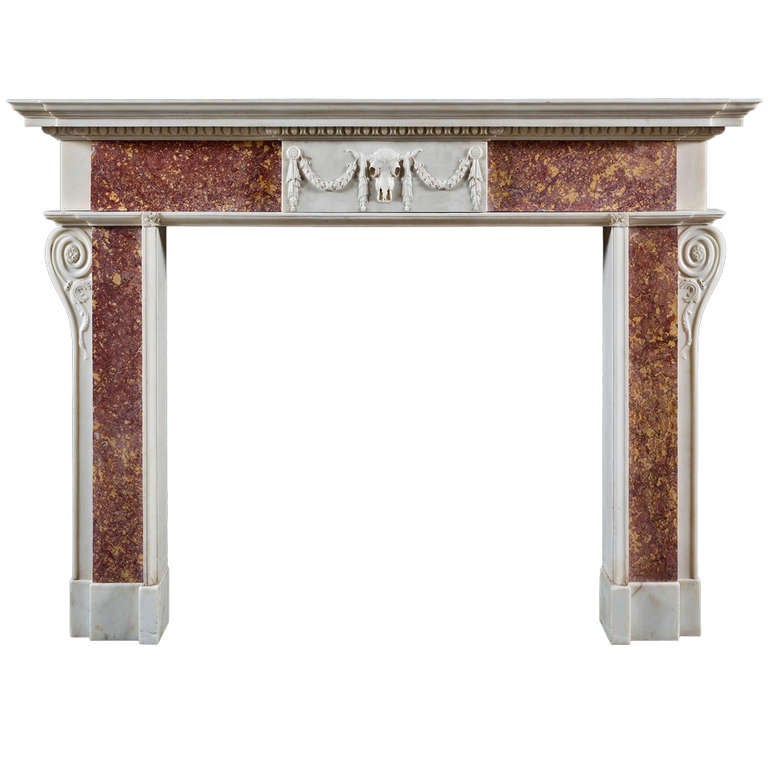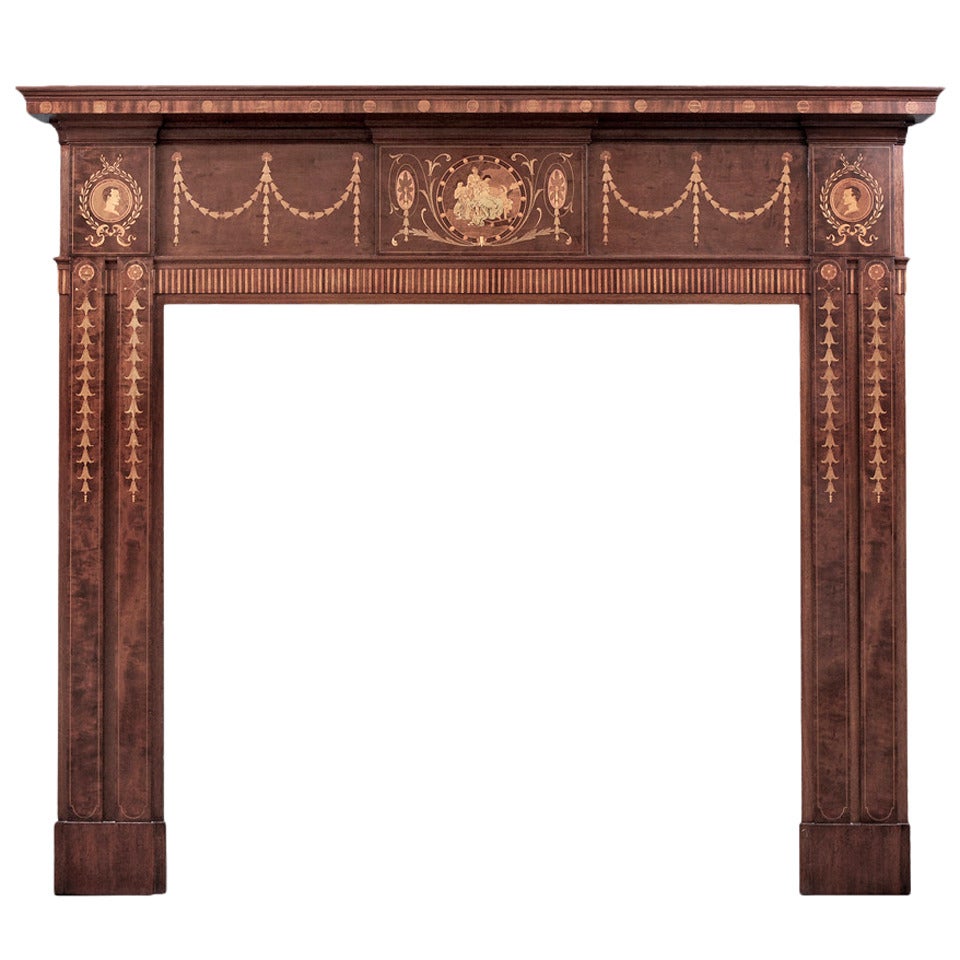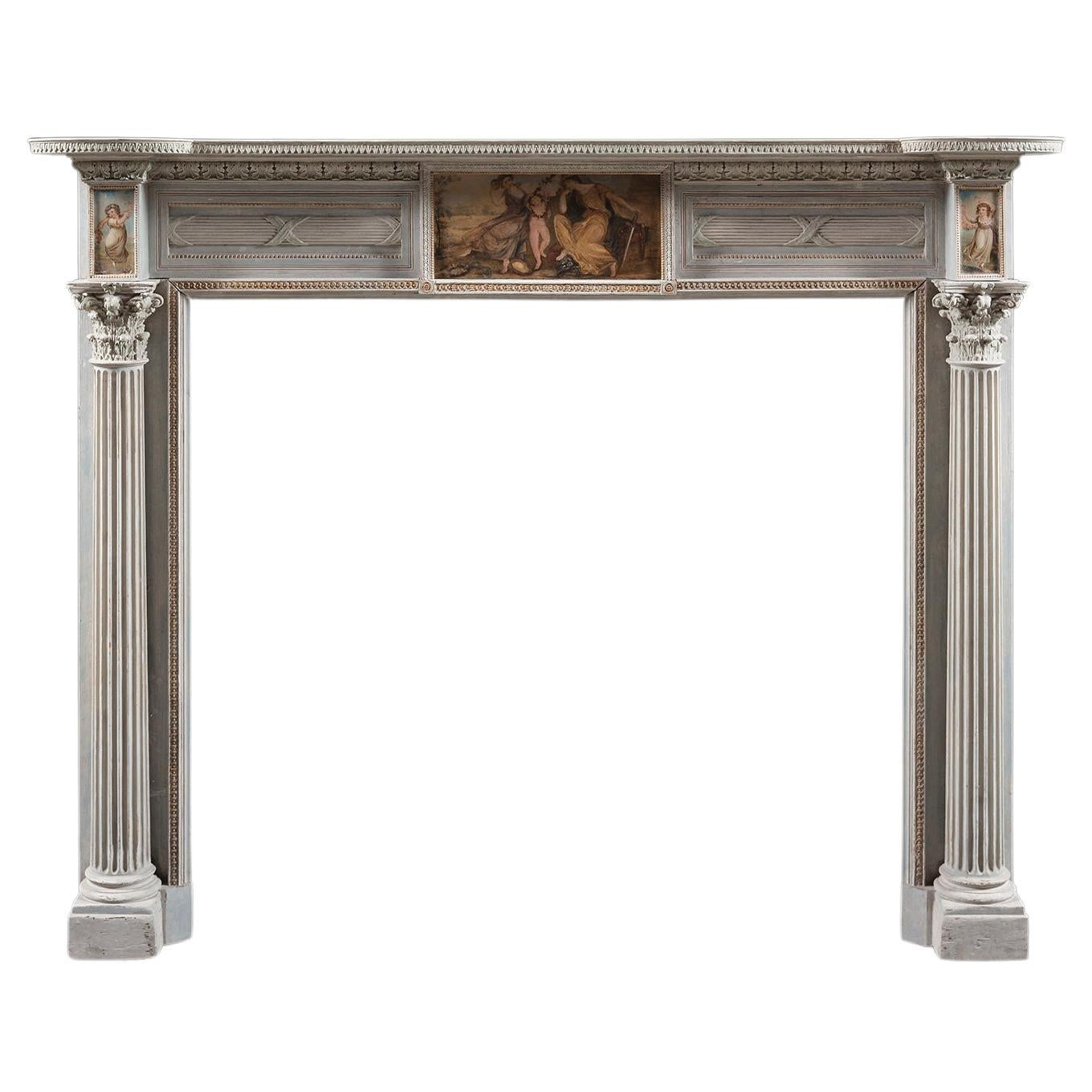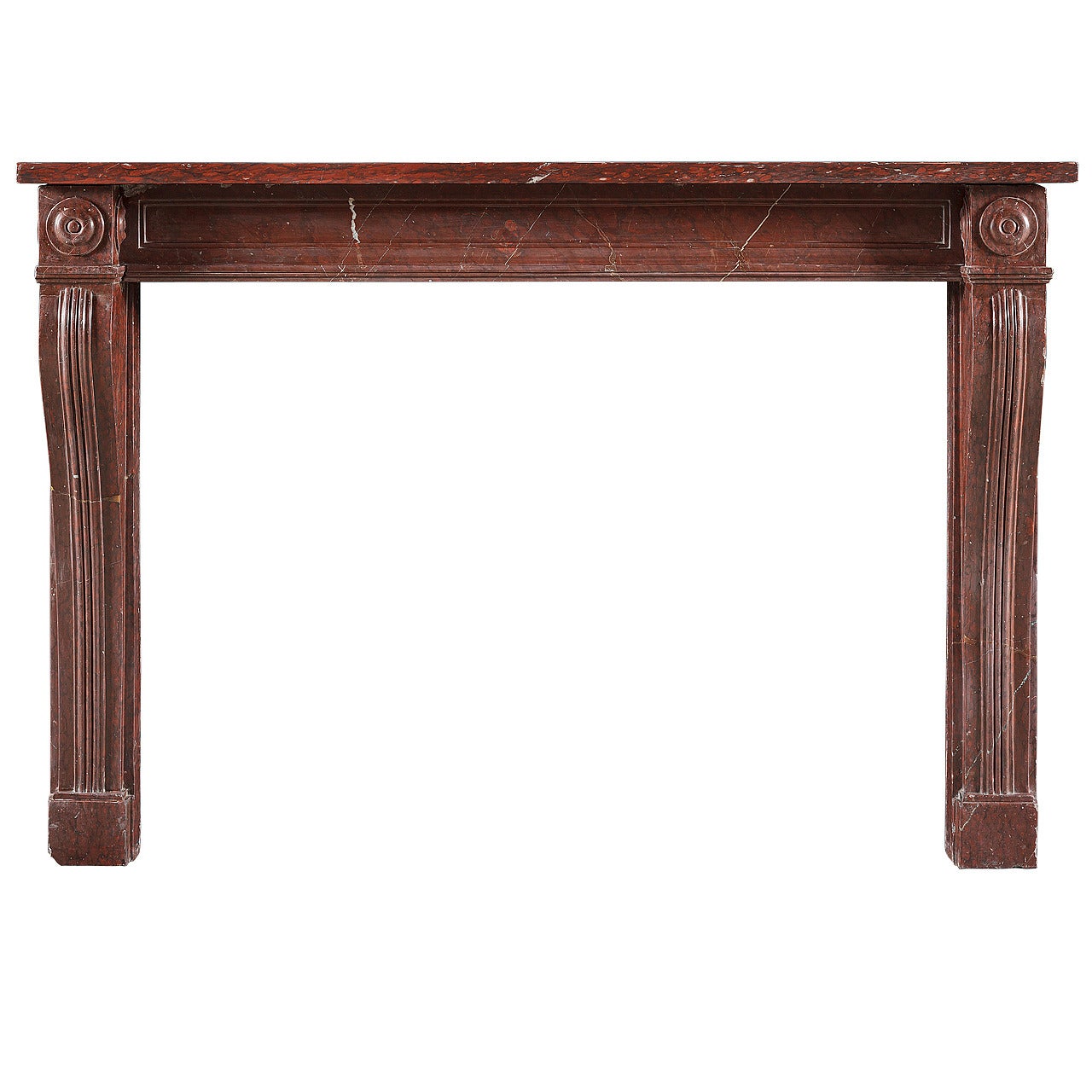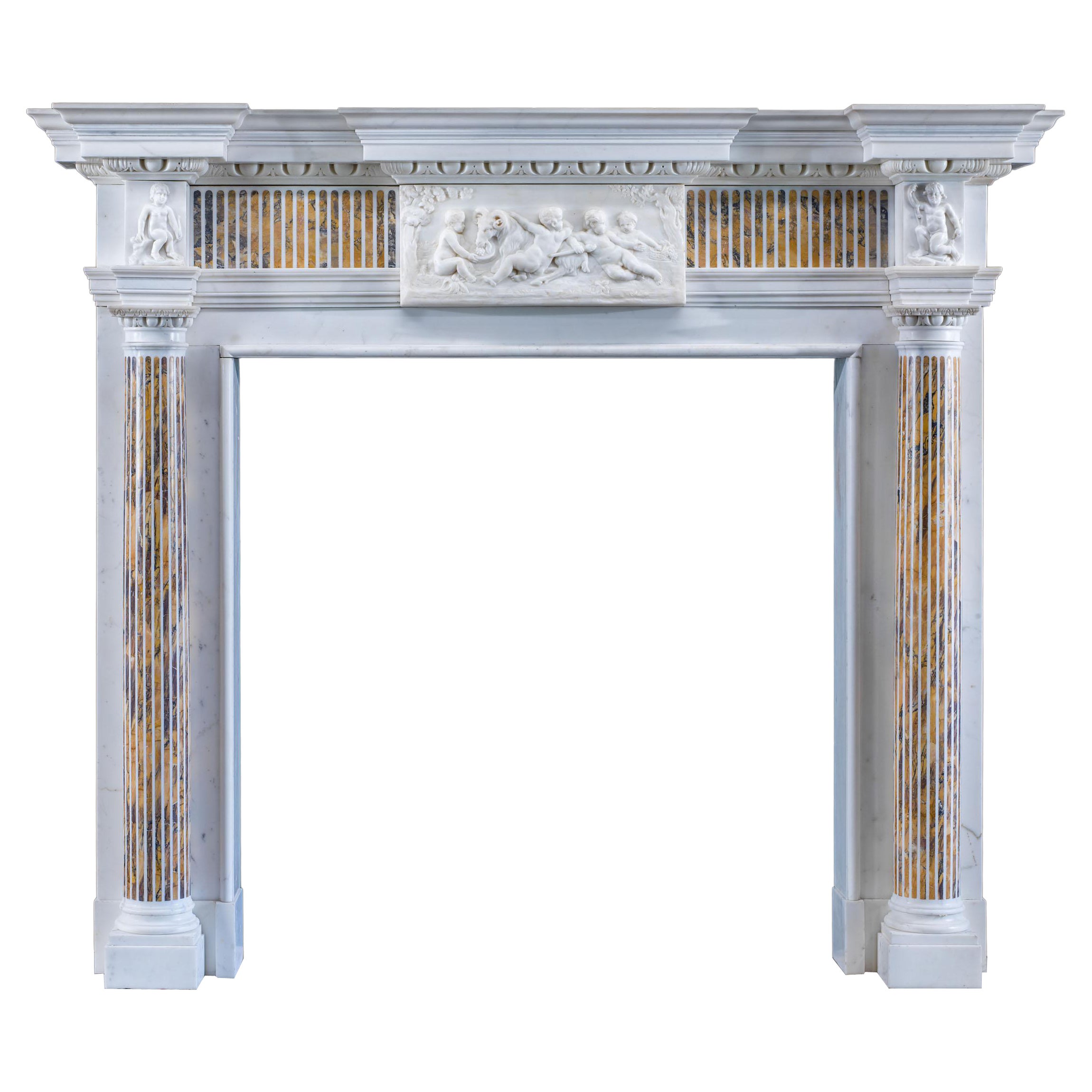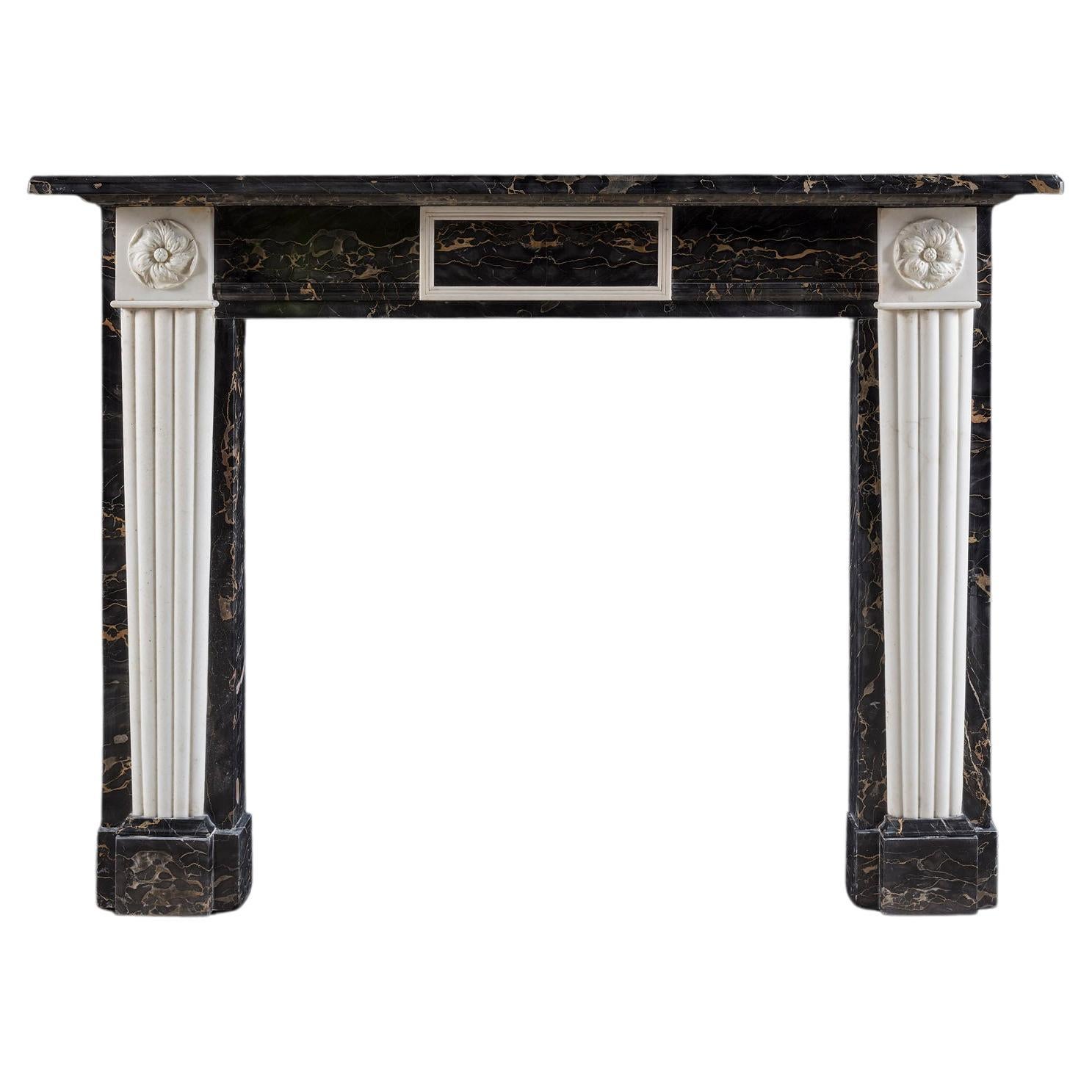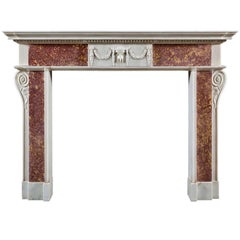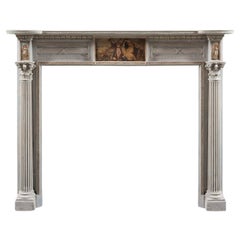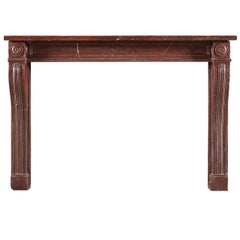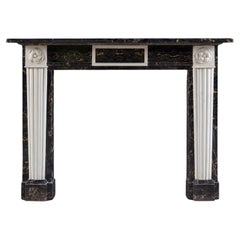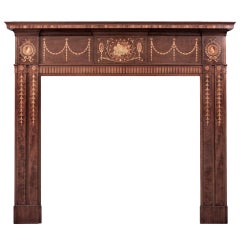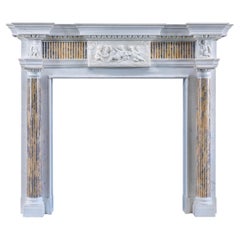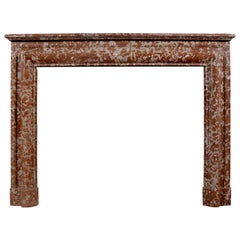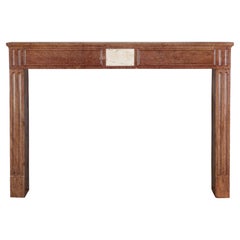Items Similar to A Highly Important Empire Period Rosso Antico Chimneypiece with Portrait Reliefs
Want more images or videos?
Request additional images or videos from the seller
1 of 12
A Highly Important Empire Period Rosso Antico Chimneypiece with Portrait Reliefs
$170,234.24
£125,000
€146,467.84
CA$238,951
A$261,385.32
CHF 136,185.18
MX$3,145,052.43
NOK 1,724,603.95
SEK 1,619,237.81
DKK 1,093,755.52
About the Item
A Highly Important Empire Period Rosso Antico Chimneypiece Inset with Specimen Marble Portrait Reliefs of Roman Emperors
The carved and veneered surround comprising a moulded
shelf supported by a bold dentil cornice, above an inverted breakfront frieze carved with a central triglyph panel, flanked by a pair of rosettes carved in shallow relief, the frieze mounted with six carved hardstone profile portrait medallions of Roman Emperors, the stop-fluted jambs raised on moulded footblocks; in excellent condition with small restorations commensurate with age and use; the pale inclusions in the stone naturally formed.
This spectacular neoclassical marble chimneypiece is carved from Rosso antico, the frieze inset with six portrait reliefs of Roman Emperors, each carved in marmo giallo on a bardiglio background, five variously incised: VESPASIANUS, TIBERIVS, OTHO, JULIUS CAESAR, TITUS.
Rosso antico (marmor taenarium) is first recorded as being quarried in 1700 BC at Akra Tainaron (Cape Matapan), Greece.¹ The majority of this stone, however, was extracted throughout the Roman period, when it was one of the most coveted materials for carving due to its rich red colouring and association with highly prized Egyptian ‘Imperial’ Porphyry.² Rosso antico was chosen in antiquity for portrait busts, notably depicting Bacchic subjects such as Dionysus and satyrs due to its rich red wine colour which symbolised conviviality whilst conveying the education and cultivated taste of the owner.³ In the Renaissance, Rosso antico was also used for architectural detail on important buildings, such as the steps leading up to the choir in the medieval church of S. Prassede, and the large columns at the entrance to the Camera dell'Aurora.⁴
In 121 AD, G. Suetonius Tranquillus, secretary to Emperor Hadrian, wrote a biographical history of the first twelve emperors of Rome entitled De vita Caesarum (The Twelve Caesars). A Renaissance edition of Tranquillus’ work was published in 1470, followed by further reprints and translations into all the main European languages. Many of these were illustrated with prints of emperors taken from coins and statues, or imagined by the artist based on Tranquillus’ accounts. These interpretations were copied, in turn, by Renaissance designers for medals, Limoges enamels, and busts, as well as paintings such as the Eleven Caesars, a series of eleven half-length portraits of Roman emperors made by Titian in 1536–40 for Federico II, Duke of Mantua.⁵ These paintings were later given to King Charles I, before being passed in the Commonwealth to the Kings of Spain. Unfortunately, the series was destroyed in the catastrophic fire of 1734 at the Royal Alcazar of Madrid, and is now only known through copies and engravings.⁶
From the middle of the 17th century until the end of the 18th century, there was an insatiable demand for marble carvings, often sold as Roman or assembled from ancient fragments, thus perpetuating the reverence for antiquity that was the quintessence of the Grand Tour. Rosso antico was in extremely short supply, even after the ancient quarries at Skutari were rediscovered in 1830, and remained one of the most highly valued of all stones. Described in 1776 as ‘dark red; scarce and dear’, it was mostly used for small objects such as Grand Tour desk ornaments, inevitably using material re-cut from classical fragments, due to its rarity, as was the case with porphyry.⁷ The portrait roundels on this chimneypiece are typical of those produced in Rome and Florence in hardstones, semi-precious stones, gold, silver, bronze, and mother-of-pearl, which, being easily transportable, would be taken home from the Grand Tour to be mounted within wooden, gilded or brass frames, as fashion dictated.⁸ A group of gold portraits of Caesars, dating from around 1660, are in the Museo Nazionale del Bargello in Florence. Images of Roman emperors were not limited to Italy, England and France, however, as examples executed in Deshima for the Dutch East India Company (Verenigde Oost-Indische Compagnie) show. Medallions depicting Roman emperors, invariably made of black and gold Japanese hiramakie or takamakie lacquer on copper, were produced for the Dutch market at the end of the 18th century. Examples can be found in the Rijksmuseum, Amsterdam.⁹
There are two possible sources for the Imperial profiles on the chimneypiece: the engravings of The Twelve Caesars by Marcantonio Raimondi, or the Imperatorum Imagines by Hubert Golz.¹⁰ The portrait medallions also bear remarkable resemblance to a set of eighteen carved portrait reliefs of Roman Emperors, also of marmo giallo, almost certainly bought by David Ker (1742–1811) of Portavo, Co. Down, on his Grand Tour between 1792–4 in either Florence or Rome. Ker’s diary entry for 17th October 1793 is interesting as it reveals that he was offering his brother a choice of chimneypiece designs, which further supports a Roman origin for the offered example.¹¹ Indeed, fire surrounds incorporating antique fragments had been promoted from the late 1760s by Giovanni Battista Piranesi (1720–78), encouraged by Rome-trained architects including Robert Adam (d.1792). One such example, inset with mythological tablets carved from Rosso antico, was acquired by the 9th Earl of Exeter from Piranesi himself for Burghley House.¹² Another can be found at Islington House, Dorset.¹³ A third, inset with giallo antico and Rosso antico, follows Piranesi’s engraved design dated 1769 for a fire surround mounted with three marble portrait reliefs.¹⁴ It should be re-emphasised that Rosso antico was so precious that it was only ever used for small tablets or details rather than an entire chimneypiece, as with the offered example; likewise, while portrait reliefs are occasionally seen on the jambs of Italian surrounds, it is exceptionally rare to see the frieze mounted with a group, especially of this scale: the combination indicates an architectural commission by an extremely wealthy patron.
The sophisticated lines of this chimneypiece epitomise the French Empire influence on the Italian states at the turn of the 18th century. This idiosyncratic ‘Roman’ taste is encapsulated by that of Napoleon, who identified with Rome’s Imperial past. Napoleon’s desire to establish a visual link between himself and Roman emperors is demonstrated by the portraits of his court painter, Jacques-Louis David, inspired by portraits of Emperor Augustus. This Imperial taste extended to architecture, furniture and porcelain, the latter two of which are combined in a group of magnificent ormolu-mounted guéridons commissioned in Sèvres between 1803–11, made to immortalise Napoleon’s reign.¹⁵ The second guéridon in the series, the Table des Grands Capitaines (Table of the Great Commanders of Antiquity), commissioned in 1806, is made almost entirely of hard-paste Sèvres porcelain. The top, painted in imitation of sardonyx, is centred by a portrait cameo of Alexander the Great, surrounded by twelve smaller heads of commanders and philosophers from antiquity: Pericles, Scipio Africanus, Pompey, Augustus, Septimus Severus, Constantine, Trajan, Caesar, Mithridates, Hannibal, Themistocles and Miltiades.¹⁶ Louis XVIII presented the table to the Prince Regent (later King George IV) in 1817 as a token of appreciation for Napoleon’s defeat two years earlier, and George IV treasured it so highly that it became part of the ceremonial backdrop for all his state portraits. The table remains in the Royal Collection.¹⁷
This chimneypiece remained, until recently, in the possession of a noble Dutch family, who acquired it from the owners of a bombed Knightsbridge house in the 1940s; unfortunately, its provenance prior to this has been lost.
The use of Rosso antico on this scale, inset with these splendid Imperial profile medallions, appears unparalleled.
1. J. B. Grossman, 'Looking at Greek and Roman Sculpture in Stone' (Los Angeles, 2003). Grossman states that this material was ‘...quarried in three places during antiquity: on Cape Tainaron present day Matapan on the Peloponnese of Greece; on Crete; and at the site of Iasos in Asia Minor.
2. L. Lazzarini, ‘Rosso antico and other red marbles used in antiquity: a characterization study’, Marble, Art Historical and Scientific Perspectives on Ancient Sculpture’ (1990), 237–252. C. Gorgoni, L. Lazzarini, P. Pallante, ‘New archaeometric data on Rosso antico and other red marbles used in antiquity, ASMOSIA VI, Interdisciplinary Studies on Ancient Stone’ (2002), pp. 199–206. J. Deér, trans. G.A. Gilhoff, The Dynastic Porphyry Tombs of the Norman Period in Sicily (Cambridge, 1959), p. 144. R. Gnoli, Marmora Romana (Rome, 1988), pp. 187–191.
3. A notable example is a satyr from the Emperor Hadrian's villa at Tivoli, now in the Capitoline Museum, Rome. Another is the head of a satyr in the Minneapolis Institute of Arts, accession no. 2006.110. See T. Opper, Hadrian. Empire and Conflict (London, 2008), p. 165, fig. 149.
4. De Luca, Marmi antichi (Rome, 1998), p. 126. Faustino Corsi, Catalogo ragionato d’una collezione di pietre di decorazione (Rome, 1833), p. 93.
5. For related Limoges medallions, see set of ten circular Limoges enamel medallions depicting Roman emperors, en grisaille with gilding, from the workshop of Jacques I Laudin, sold Christie’s London, Fine Renaissance Bronzes and Works of Art, 19 December, 1977, lot 95.
6. See set of drawings sold Sotheby’s London, Of Royal and Noble Descent, 24 February, 2015, lot 184.
7. J. J. Ferber, Raspe’s Travels through Italy in the Years 1771–1772 (London, 1776), p. 218.
8. See Sotheby’s London, Pelham, the Public and the Private, 8 March 2016, lot 75: ‘A set of twelve mother-of-pearl cameos of Roman Emperors, Southern Italian, early 19th century’
9. Oliver Impey, Christiaan J.A. Jörg, Cynthia Viallé, Japanese Export Lacquer 1580–1850 (Amsterdam, 2005) pp. 48–57, no. 56 & 57.
10. For a further reference, see the candlesticks by Jacques I Laudin in the Waters Art Gallery, illustrated in P. Verdier, Catalogue of the Painted Enamels of the Renaissance (Baltimore, 1967), p. 389, nos. 207 & 208.
11. John Ingamells, A Dictionary of British and Irish travellers in Italy 1701–1800 (London, 1997), pp. 572–3.
12. Oliver Impey, Four Centuries of Decorative Arts from Burghley House (Virginia, 1998),
p. 53, fig. 23.
13. Country Life, 12 June, 1997, p. 162, figs. 9–11.
14. A. González-Palacios, Il Tempio del Gusto, Roma e il Regno delle due Sicilie, Vol. II (Milan, 1984), pp. 592–93, p. 260.
15. S. Grandjean, 'Napoleonic Tables from Sèvres', The Connoisseur (1959), p. 153
16. G. de Bellaigue, 'A Royal Keepsake The Table of the Grand Commanders', Furniture History Society, Vol. XXXV (1999), pp. 112–41.
17. See RCIN 2364.
Height 48⅞in (124cm) width 67in (170cm)
Internal height 36½in (92.5cm) width 41in (104cm)
Footblock to footblock 59in (151.5cm)
Shelf depth 12in (30.5cm)
- Dimensions:Height: 48.82 in (124 cm)Width: 66.93 in (170 cm)Depth: 12.01 in (30.5 cm)
- Style:Empire (Of the Period)
- Materials and Techniques:
- Place of Origin:
- Period:
- Date of Manufacture:c. 1800
- Condition:Repaired: Restorations. Wear consistent with age and use.
- Seller Location:London, GB
- Reference Number:Seller: G4271stDibs: LU848140566512
About the Seller
No Reviews Yet
Vetted Professional Seller
Every seller passes strict standards for authenticity and reliability
Established in 2001
1stDibs seller since 2008
35 sales on 1stDibs
Typical response time: 1 to 2 days
- ShippingRetrieving quote...Shipping from: Mitcham, United Kingdom
- Return Policy
Authenticity Guarantee
In the unlikely event there’s an issue with an item’s authenticity, contact us within 1 year for a full refund. DetailsMoney-Back Guarantee
If your item is not as described, is damaged in transit, or does not arrive, contact us within 7 days for a full refund. Details24-Hour Cancellation
You have a 24-hour grace period in which to reconsider your purchase, with no questions asked.Vetted Professional Sellers
Our world-class sellers must adhere to strict standards for service and quality, maintaining the integrity of our listings.Price-Match Guarantee
If you find that a seller listed the same item for a lower price elsewhere, we’ll match it.Trusted Global Delivery
Our best-in-class carrier network provides specialized shipping options worldwide, including custom delivery.More From This Seller
View AllSuperb George III Neoclassical Fireplace Mantel of the Roman Doric Order
By Sir William Chambers
Located in London, GB
In white statuary and Spanish Brocatelle marbles; The design attributed to Sir William Chambers (1723-1796), architect to the King, circa 1765-1770.
The tiered shelf with egg and dart, (symbolic of good and evil) moulding, above the frieze, which is centered with a rectangular tablet, superbly sculpted with a Bucranium mask of an ox skull. This has horns and a jeweled decoration adorns the skull above the eyes, the horns are draped with bunched, knotted ribbons, which hold swags of tied bell flowers, the other end of which are secured and fall from circular, flower decorated paterae. This is flanked by Brocatelle panels and recessed, statuary end blockings. The jambs with pilaster Brocatelle uprights, flanked by statuary out grounds with scrolling volutes decorated with sprigs of foliage. The opening with moulded edge, the whole raised on foot blocks.
The Doric Order...
Category
Antique Mid-18th Century British Neoclassical Fireplaces and Mantels
Materials
Marble, Statuary Marble
A Refined Neoclassical Eighteenth Century Chimneypiece in Painted Timber
By Angelica Kauffmann
Located in London, GB
A hand-painted panel after a Neoclassical design in the manner of Angelica Kaufmann is at centre of the frieze, depicting a cupid holding a thyrsus, playing together with two female ...
Category
Antique Early 18th Century English Neoclassical Fireplaces and Mantels
Materials
Wood
A Modest & Attractive Charles X Rouge Griotte Chimneypiece
Located in London, GB
A French, Circa 1830 Charles X Rouge Griotte antique fireplace. The rectangular mantelpiece above a recessed panel-carved frieze flanked by roundel-carved blocks on shaped reeded jam...
Category
Antique 1830s French Charles X Fireplaces and Mantels
Materials
Marble, Griotte Marble
An Exceptional Regency Style Chimneypiece in Portoro Nero & Statuary Marbles
Located in London, GB
An exceptional, early 20th century, Regency style chimneypiece in Portoro Nero and statuary marbles. The central tablet is a book matched specimen veneer of phenomenal quality, borde...
Category
Early 20th Century English Regency Fireplaces and Mantels
Materials
Marble, Statuary Marble
A Superb & Rare George III Neoclassical Chimneypiece in Marbles and Painted Pine
By George Brookshaw
Located in London, GB
A Superb and Rare George III, Neoclassical Siena and Statuary Marble and Painted Pine Fireplace with Porphyry and Antico Verde Faux Marbles
Circa 1785–95. Inset with painted polychr...
Category
Antique Late 18th Century English George III Fireplaces and Mantels
Materials
Marble, Siena Marble, Statuary Marble, Porphyry, Copper
An Important Early 20th Century Commemorative Neoclassical Style Chimneypiece
Located in London, GB
An important, early 20th century, English, statuary and Siena marble fireplace, celebrating the end of the Great War of 1914–18. Most likely a special commission from the famous Whit...
Category
Early 20th Century English Adam Style Fireplaces and Mantels
Materials
Marble, Siena Marble, Statuary Marble
You May Also Like
19th Century English Mahogany Chimneypiece
Located in London, GB
A 19th century English mahogany fireplace. The frieze inlaid with swags and bell drops, the centre panel with plaque featuring figures a...
Category
Antique 19th Century British Fireplaces and Mantels
Materials
Mahogany
Fine Neoclassical Siena Inlaid Chimneypiece
Located in London, GB
A fine and grand neoclassical chimneypiece in statuary marble with Siena marble inlay. The boldly carved breakfront shelf sits above a high relief egg and dart undershelf and a finel...
Category
Antique 1760s English George III Fireplaces and Mantels
Materials
Marble
$73,601 Sale Price
20% Off
Large 19th Century English Rouge Royale Fireplace Mantel
Located in London, GB
19th century English Rouge Royale fireplace, with bolection moulding.
Shelf Width: 1850 mm 72 7/8 in
Overall Height: 1390 mm 54 3/4 in
Opening Height: 1150 mm 45 1...
Category
Antique 19th Century English Queen Anne Architectural Elements
Materials
Marble
Louis XVI Red Stone Fireplace - Traditional Chic Study - Antique Fireplace
Located in Beervelde, BE
This authentic late 18th century Louis XVI style French antique fireplace surround is expertly crafted from rich, warm-toned red porfirrisch hard stone, beautifully accented with a r...
Category
Antique Late 18th Century French Louis XVI Fireplaces and Mantels
Materials
Stone, Marble
18th Century Red Stone Chique Classic Vintage Fireplace Surround
Located in Beervelde, BE
A fine French Louis XVI period chimneypiece with marble inlay from the 18th century. The little shade difference on jambs gives it a rustic look.
Measures:
161 cm exterior width ...
Category
Antique 18th Century French Louis XVI Fireplaces and Mantels
Materials
Stone
19th Century Fine European Antique Fireplace Mantle
Located in Beervelde, BE
A quite special original antique fireplace surround in Burgundy bicolor marble hard stone with porfierstone inlay. The different colors and straight lines makes that this could perfe...
Category
Antique 19th Century French Louis XVI Fireplaces and Mantels
Materials
Stone
More Ways To Browse
Rosso Antique
Marble Relief
Antique Bombs
Portrait Medallion
French Country With Marble Top
Antique Marble Relief
Prince Regent
Portrait Relief
Early 19th Century Secretary Desk
19th Century Silver French Candlesticks
Antique Drawing Set
Breakfront Carved
Porcelain D Art Limoges France
Relief Frieze
Antique Crete
Marble Busts Of Roman Emperors
Antique Aurora
Roman Cameo
